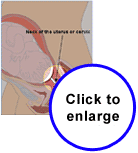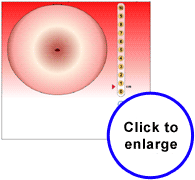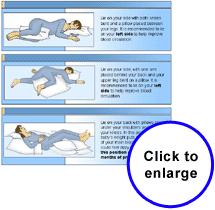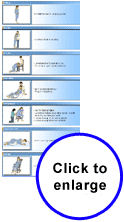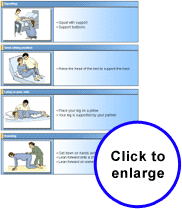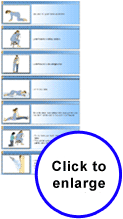B. PREPARING FOR CHILDBIRTH
Labour and birth are hard work and require a lot of energy, will, and effort. There are two keys to comfort during pregnancy. The first is understanding and working with the labour process. The second is learning and practicing as many comfort measures as possible.

You never know what will feel good during labour, so it's a good idea to have different things to try.
a. The Stages of Labour and Delivery
During the nine months of your pregnancy, your baby has been growing in your uterus. The uterus is a pocket made of very strong muscles which stretch as your baby grows. The neck of the uterus, called the cervix, opens into the vagina. During your pregnancy the cervix is thick and is closed with a mucous plug.
During labour, the muscles of the uterus tighten and relax to open up the cervix and help the baby move out of the uterus. This tightening is called a contraction
Labour is divided into three stages. By learning about and practicing breathing, relaxation, and other comfort measures, you can prepare yourself for all stages of labour.
1. First Stage
2. Second Stage
3. Third Stage
The third stage, which takes about 5 to 30 minutes, involves the expulsion of the placenta. The placenta that fed your baby in the uterus comes out in the same way as the baby.
b. Relaxation
Learning to relax is one of the best ways to work with your contractions during labour. You will find the detailed instructions in Module 6 entitled "Healthy Activity".
Since you never know what will feel good during labour, it is a good idea to practice relaxing in many different positions. Here are a few examples of relaxation positions.
Remember, however, that there is one relaxation position that you should avoid. Do not lie flat on your back after your 16th week of pregnancy. This is because the weight of your uterus presses on your blood vessels and can reduce blood flow to you and your baby.
c. Positions
It is a good idea to practice all the possible positions that you might find comfortable during your labour. Practice them until they become comfortable.
Here are a few important points to remember.
The following table demonstrates a few positions to try during the first stage of labour.
The following table demonstrates a few positions to try during the second stage of labour - pushing.
d. Types of Massage
You never know what kind of massage is going to feel good. The best idea is to experiment and try out different kinds of massage. Then, when the time comes, you will have choices.
General information for the person giving the massage.
The following animations demonstrate the main massage techniques.
 to see the effleurage (light massage) technique.
to see the effleurage (light massage) technique.
e. Comfort Measures
Breathing, relaxation, finding comfortable positions, and massage will all help you feel better during labour.
Remember that labour is different for each woman. There are no good or bad techniques; only techniques that are more or less effective. Try different ones to find what works best for you.
Test Your Knowledge
|
|
The following exercise will help you learn more about the measures that provide a comfort during labour and delivery.
Click on the option button which corresponds to the correct answer and verify your answer by clicking on the "Check" button.
|
1 |
Among the following options, which is the most appropriate to help the mother relax? |
|
2 |
How can hydrotherapy be useful during labour and delivery? |
|
3 |
Among the following measures, which one is the most appropriate during labour and delivery? |
|
4 |
What could you do to replace the lost fluids, maintain your level of energy, and quench your thirst? |
|
5 |
What could you do to focus your attention during your contractions? |
|
6 |
Which among the following items could be useful during labour and delivery? |
f. Back Pain
Most women feel contractions in their lower abdomen, but about one in four women will feel them in their back. The back pain is caused by the baby's back pressing against your back. This back pain is usually felt just under your waist and lasts for most of the first stage of labour.
The following advice will help alleviate back pain during labour.
The birthing ball can be very useful if you feel contractions in your lower back. You can lean on it when you are on your hands and knees.
This is how to use the birthing ball to alleviate lower back pain.
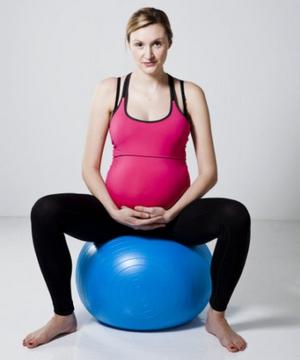 |
 |
This position encourages movement of the pelvis and the hips and uses gravity to help the baby rotate which will be less painful for you.
g. Breathing
Breathing is natural and most of the time, we don't even think about it. However, during delivery, the way you breathe can make a real difference. Learning to pace your breathing can help you relax during your labour. Your breathing can make your contractions more effective.
Choose the breathing technique that is best for you. Labour is different for each woman. Look at breathing techniques and rhythm as tools to help you during your labour.

1. Slow Deep Breathing
Your normal breathing may be slower or faster than another person. Begin by relaxing and breathing so that you are comfortable.
Most women begin with slow deep breathing and continue as long as they feel comfortable.
 for a description of the slow deep breathing technique.
for a description of the slow deep breathing technique.
 to hear the slow deep breathing technique.
to hear the slow deep breathing technique.
To practice this breathing technique, you or your partner can place a hand on your belly or your chest. You will notice that your chest rises and falls with each breath. Your partner can check that your arms and shoulders remain relaxed.
2. Faster Shallow Breathing
This is the breathing technique you can use if your contractions become more intense, and you have difficulty relaxing using the slow deep breathing technique. Faster, shallow breathing is done more quickly and higher in your chest.
 for a description of the faster, shallow breathing technique.
for a description of the faster, shallow breathing technique.
 to hear the "faster shallow breathing" technique.
to hear the "faster shallow breathing" technique.
To practice the faster, shallow breathing technique, begin by taking short rapid breaths. Each breath should be light and shallow.
Try breathing at different speeds until you find one that is comfortable for you. Practice this breathing until you can stay relaxed and comfortable for 60 to 90 seconds.
3. Pant-Blow Breathing
This breathing technique will help you to relax when your contractions are longer and stronger and you can no longer relax using the other breathing techniques. This technique is also referred to as transition breathing.
Pant-blow breathing is done through the mouth. You take several fast, shallow breaths and then you blow out
The shallow breaths make a quiet "heh" sound. Choose any rhythm that is best for you. Many women are comfortable with "heh, heh, heh, heh, and blow" (four fast pants to one complete blow). You can also try other rhythms like "heh, heh, blow" (two fast pants to one complete blow) or "heh, heh, heh, blow" (three fast pants to one complete blow). Try them all in order to choose the one that is best for you.
 for a description of the pant-blow breathing technique.
for a description of the pant-blow breathing technique.
 to hear the pant-blow breathing technique.
to hear the pant-blow breathing technique.
This type of breathing is used during the transition phase that happens towards the end of the first stage. At this point, contractions can last for about 90 seconds and can be very close together
Practice until you can stay relaxed and comfortable for 90 seconds while doing pant-blow breathing.
4. Breathing to Help You Stop Pushing
At certain moments during labour, you will feel the urge to push, but your health care provider may ask you NOT TO PUSH.
 for a description of the breathing technique to help you stop pushing.
for a description of the breathing technique to help you stop pushing.
 to hear the breathing technique to help you stop pushing.
to hear the breathing technique to help you stop pushing.
You can practice breathing to stop pushing. While you are practicing your pant-blow breathing, have your partner say "urge to push." Switch to blowing out for a few seconds until your partner says "urge passes." Then return to pant-blow breathing.
5. Breathing While Pushing
Once your cervix is fully open, your health care provider will ask you to push when you feel the urge. This may occur several times during each contraction.
When a contraction begins, take a relaxing breath - in through your nose or mouth and out through the nose or mouth.
Practice any breathing technique that is comfortable until you feel the urge to push.
When you feel the urge to push:
- Relax your pelvic floor muscles.
- Tuck in your chin and curl your trunk forward.
- Tighten lips and breathe out very slowly.
- Continue breathing until the urge to push leaves.
There are other methods of breathing while you push. Your health care provider may suggest a different one at delivery time. Use the method that works best for you.

h. Practicing for Labour
A labour rehearsal is a chance for you and your partner to put together all the new techniques you have learned.
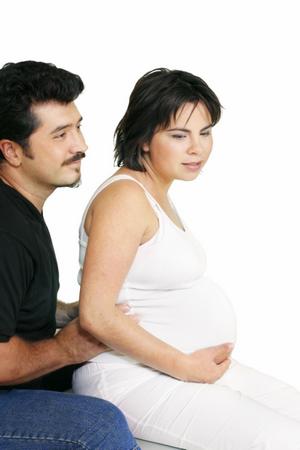
During the rehearsal, your partner talks you through imaginary contractions. Your role is to practice breathing and relaxation methods in time with these imaginary contractions. Your partner must also check to be sure that you are relaxed. If you are tense, gentle stroking or touching can help you relax.
You can also follow "Your Guide to Labour and Delivery" found further on in this module to help connect your labour rehearsal to the real thing.
